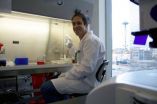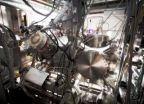(Press-News.org) Nobody knows the remarkable properties of human skin like the researchers struggling to emulate it. Not only is our skin sensitive, sending the brain precise information about pressure and temperature, but it also heals efficiently to preserve a protective barrier against the world. Combining these two features in a single synthetic material presented an exciting challenge for Stanford Chemical Engineering Professor Zhenan Bao and her team.
Now, they have succeeded in making the first material that can both sense subtle pressure and heal itself when torn or cut. Their findings will be published on November 11 in the journal Nature Nanotechnology.
In the last decade, there have been major advances in synthetic skin, said Bao, the study's principal investigator, but even the most effective self-healing materials had major drawbacks. Some had to be exposed to high temperatures, making them impractical for day-to-day use. Others could heal at room temperature, but repairing a cut changed their mechanical or chemical structure, so they could only heal themselves once. Most importantly, no self-healing material was a good bulk conductor of electricity, a crucial property.
"To interface this kind of material with the digital world, ideally you want them to be conductive," said Benjamin Chee-Keong Tee, first author of the paper.
A NEW RECIPE
The researchers succeeded by combining two ingredients to get what Bao calls "the best of both worlds" – the self-healing ability of a plastic polymer and the conductivity of a metal.
They started with a plastic consisting of long chains of molecules joined by hydrogen bonds – the relatively weak attractions between the positively charged region of one atom and the negatively charged region of the next.
"These dynamic bonds allow the material to self-heal," said Chao Wang, a co-first author of the research. The molecules easily break apart, but then when they reconnect, the bonds reorganize themselves and restore the structure of the material after it gets damaged, he said. The result is a bendable material, which even at room temperature feels a bit like saltwater taffy left in the fridge.
To this resilient polymer, the researchers added tiny particles of nickel, which increased its mechanical strength. The nanoscale surfaces of the nickel particles are rough, which proved important in making the material conductive. Tee compared these surface features to "mini-machetes," with each jutting edge concentrating an electrical field and making it easier for current to flow from one particle to the next.
The result was a polymer with uncommon characteristics. "Most plastics are good insulators, but this is an excellent conductor," Bao said.
BOUNCING BACK
The next step was to see how well the material could restore both its mechanical strength and its electrical conductivity after damage.
The researchers took a thin strip of the material and cut it in half with a scalpel. After gently pressing the pieces together for a few seconds, they found the material gained back 75 percent of its original strength and electrical conductivity. The material was restored close to 100 percent in about 30 minutes. "Even human skin takes days to heal. So I think this is quite cool," said Tee.
What's more, the same sample could be cut repeatedly in the same place. After 50 cuts and repairs, a sample withstood bending and stretching just like the original.
The composite nature of the material created a new engineering challenge for the team. Bao and her co-authors found that although nickel was key to making the material strong and conductive, it also got in the way of the healing process, preventing the hydrogen bonds from reconnecting as well as they should.
For future generations of the material, Bao said the team might adjust the size and shape of the nanoparticles, or even the chemical properties of the polymer, to get around this trade-off.
Nonetheless, Wang said the extent of these self-healing properties was truly surprising: "Before our work, it was very hard to imagine that this kind of flexible, conductive material could also be self-healing."
SENSITIVE TO THE TOUCH
The team also explored how to use the material as a sensor. For the electrons that make up an electrical current, trying to pass through this material is like trying to cross a stream by hopping from stone to stone. The stones in this analogy are the nickel particles, and the distance separating them determines how much energy an electron will need to free itself from one stone and move to another.
Twisting or putting pressure on the synthetic skin changes the distance between the nickel particles and, therefore, the ease with which electrons can move. These subtle changes in electrical resistance can be translated into information about pressure and tension on the skin.
Tee says that the material is sensitive enough to detect the pressure of a handshake. It might, therefore, be ideal for use in prosthetics, Bao added. The material is sensitive not only to downward pressure but also to flexion, so a prosthetic limb might someday be able to register the degree of bend in a joint.
Tee pointed out other commercial possibilities. Electrical devices and wires coated in this material could repair themselves and get electricity flowing again without costly and difficult maintenance, particularly in hard-to-reach places, such as inside building walls or vehicles.
Next up, Bao said the team's goal is to make the material stretchy and transparent, so that it might be suitable for wrapping and overlaying electronic devices or display screens.
###
Ranulfo Allen, a graduate chemical engineering student, also contributed to this research.
The research was supported by the Air Force Office of Scientific Research (AFOSR).
This article was written by Kelly Servick, a science-writing intern working for the Stanford University School of Engineering.
Touch-sensitive plastic skin heals itself
2012-11-12
ELSE PRESS RELEASES FROM THIS DATE:
36 in one fell swoop -- researchers observe 'impossible' ionization
2012-11-12
This press release is available in German.
Using the world's most powerful X-ray laser in California, an international research team discovered a surprising behaviour of atoms: with a single X-ray flash, the group led by Daniel Rolles from the Center for Free-Electron Laser Science (CFEL) in Hamburg (Germany) was able to kick a record number of 36 electrons at once out of a xenon atom. According to theoretical calculations, these are significantly more than should be possible at this energy of the X-ray radiation. The team present their unexpected observations in the ...
'Groundwater inundation' doubles previous predictions of flooding with future sea level rise
2012-11-12
Scientists from the University of Hawaii at Manoa (UHM) published a study today in Nature Climate Change showing that besides marine inundation (flooding), low-lying coastal areas may also be vulnerable to "groundwater inundation," a factor largely unrecognized in earlier predictions on the effects of sea level rise (SLR). Previous research has predicted that by the end of the century, sea level may rise 1 meter. Kolja Rotzoll, Postdoctoral Researcher at the UHM Water Resources Research Center and Charles Fletcher, UHM Associate Dean, found that the flooded area in urban ...
Game changer for arthritis and anti-fibrosis drugs
2012-11-12
(SALT LAKE CITY)—In a discovery that can fundamentally change how drugs for arthritis, and potentially many other diseases, are made, University of Utah medical researchers have identified a way to treat inflammation while potentially minimizing a serious side effect of current medications: the increased risk for infection.
These findings provide a new roadmap for making powerful anti-inflammatory medicines that will be safer not only for arthritis patients but also for millions of others with inflammation-associated diseases, such as diabetes, traumatic brain injury, ...
CSHL-led team discovers new way in which plants control flower production
2012-11-12
Cold Spring Harbor, N.Y. – Flowers don't just catch our eyes, they catch those of pollinators like bees as well. They have to, in order to reproduce. Because plants need to maximize the opportunity for pollinators to gain access to their seeds, variations in the timing of flowering can have profound effects on flower, fruit, and seed production, and consequently agricultural yields.
We know that the major driving forces of flowering are external factors such as light and temperature. However, new research from CSHL Assistant Professor Zach Lippman, Ph.D. and his collaborators, ...
Mutations in genes that modify DNA packaging result in Facioscapulohumeral Muscular Dystrophy
2012-11-12
A recent finding by medical geneticists sheds new light on how Facioscapulohumeral Muscular Dystrophy develops and how it might be treated. More commonly known as FSHD, the devastating disease affects both men and women.
FSHD is usually an inherited genetic disorder, yet sometimes appears spontaneously via new mutations in individuals with no family history of the condition.
"People with the condition experience progressive muscle weakness and about 1 in 5 require wheelchair assistance by age 40," said Dr. Daniel G. Miller, University of Washington associate professor ...
Study provides recipe for 'supercharging' atoms with X-ray laser
2012-11-12
Researchers using the Linac Coherent Light Source (LCLS) at the U.S. Department of Energy's (DOE) SLAC National Accelerator Laboratory have found a way to strip most of the electrons from xenon atoms, creating a "supercharged," strongly positive state at energies previously thought too low.
The findings, which defy expectations and theory, could help scientists deliberately induce the high levels of damage needed to study extreme states of matter or ward off damage in samples they're trying to image. The results were reported this week in Nature Photonics.
While the ...
Why Antarctic sea ice cover has increased under the effects of climate change
2012-11-12
The first direct evidence that marked changes to Antarctic sea ice drift have occurred over the last 20 years, in response to changing winds, is published this week in the journal Nature Geoscience. Scientists from NERC's British Antarctic Survey (BAS) and NASA's Jet Propulsion Laboratory (JPL), Pasadena California explain why, unlike the dramatic losses reported in the Arctic, the Antarctic sea ice cover has increased under the effects of climate change.
Maps created by JPL using over 5 million individual daily ice motion measurements captured over a period of 19 years ...
Did wild birds cause the 2010 deadly West Nile virus outbreak in Greece?
2012-11-12
In 2010, 35 people in Greece died from a West Nile virus (WNV) outbreak, with a further 262 laboratory-confirmed human cases. A new article published in BioMedCentral's open access journal Virology Journal examines whether wild or migratory birds could have been responsible for importing and amplifying the deadly virus.
WNV is a flavivirus of major public health concern, spread through the bite of infected mosquitoes. Discovered in Uganda in 1937, it was only sporadically reported up until the 1990s, after which disease outbreaks were reported world-over, leading to ...
Scientists discover new method of gene identification
2012-11-12
Scientists studying the genes and proteins of human cells infected with a common cold virus have identified a new gene identification technique that could increase the genetic information we hold on animals by around 70 to 80 per cent. The findings, published in Nature Methods, could revolutionise our understanding of animal genetics and disease, and improve our knowledge of dangerous viruses such as SARS that jump the species barrier from animals to humans.
Modern advances in genome sequencing — the process of determining the genetic information and variation controlling ...
Cultural dimensions of climate change are underestimated, overlooked and misunderstood
2012-11-12
The impact of climate change on many aspects of cultural life for people all over the world is not being sufficiently accounted for by scientists and policy-makers. University of Exeter-led research by an international team, published on 11th November in Nature Climate Change, shows that cultural factors are key to making climate change real to people and to motivating their responses.
From enjoying beaches or winter sports and visiting iconic natural spaces to using traditional methods of agriculture and construction in our daily lives, the research highlights the cultural ...



